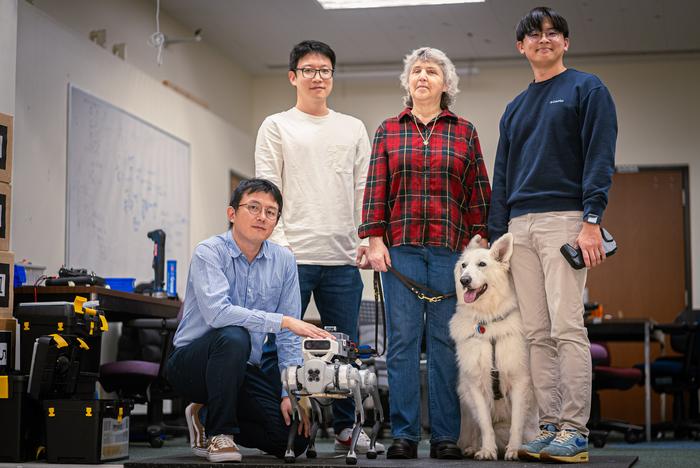May 16, 2024

Credit: Zinj Guo
May 16, 2024
To Optimize Guide-Dog Robots, First Listen to the Visually Impaired
Award-winning research led by UMass Amherst shows to be successful, Guide-dog users and trainers need to provide insight into features that make robotic helpers useful in the real world
AMHERST, Mass. — What features does a robotic guide dog need? Ask the blind, say the authors of an award-winning paper. Led by researchers at the University of Massachusetts Amherst, a study identifying how to develop robot guide dogs with insights from guide dog users and trainers won a Best Paper Award at CHI 2024: Conference on Human Factors in Computing Systems (CHI), the leading venue for human-computer interaction research.
Guide dogs enable remarkable autonomy and mobility for their handlers. However, only a fraction of people with visual impairments have one of these companions. The barriers include the scarcity of trained dogs, cost (which is $40,000 for training alone), allergies and other physical limitations that preclude caring for a dog.
Robots have the potential to step in where canines can’t and address a truly gaping need—if designers can get the features right.
“We’re not the first ones to develop guide-dog robots,” says Donghyun Kim, assistant professor in the UMass Amherst Manning College of Information and Computer Science (CICS) and one of the corresponding authors of the award-winning paper. “There are 40 years of study there, and none of these robots are actually used by end users. We tried to tackle that problem first so that, before we develop the technology, we understand how they use the animal guide dog and what technology they are waiting for.”
The research team conducted semistructured interviews and observation sessions with 23 visually impaired dog-guide handlers and five trainers. Through thematic analysis, they distilled the current limitations of canine guide dogs, the traits handlers are looking for in an effective guide and considerations to make for future robotic guide dogs.
One of the more nuanced themes that came from these interviews was the delicate balance between robot autonomy and human control. “Originally, we thought that we were developing an autonomous driving car,” says Kim. They envisioned that the user would tell the robot where they want to go and the robot would navigate autonomously to that location with the user in tow.
This is not the case.
The interviews revealed that handlers do not use their dog as a global navigation system. Instead, the handler controls the overall route while the dog is responsible for local obstacle avoidance. However, even this isn’t a hard-and-fast rule. Dogs can also learn routes by habit and may eventually navigate a person to regular destinations without directional commands from the handler.
“When the handler trusts the dog and gives more autonomy to the dog, it’s a bit delicate,” says Kim. “We cannot just make a robot that is fully passive, just following the handler, or just fully autonomous, because then [the handler] feels unsafe.”
The researchers hope this paper will serve as a guide, not only in Kim’s lab, but for other robot developers as well. “In this paper, we also give directions on how we should develop these robots to make them actually deployable in the real world,” says Hochul Hwang, first author on the paper and a doctoral candidate in Kim’s robotics lab.
For instance, he says that a two-hour battery life is an important feature for commuting, which can be an hour on its own. “About 90% of the people mentioned the battery life,” he says. “This is a critical part when designing hardware because the current quadruped robots don’t last for two hours.”
These are just a few of the findings in the paper. Others include: adding more camera orientations to help address overhead obstacles; adding audio sensors for hazards approaching from the occluded regions; understanding ‘sidewalk’ to convey the cue, “go straight,” which means follow the street (not travel in a perfectly straight line); and helping users get on the right bus (and then find a seat as well).
The researchers say this paper is a great starting point, adding that there is even more information to unpack from their 2,000 minutes of audio and 240 minutes of video data.
Winning the Best Paper Award was a distinction that put the work in the top 1% of all papers submitted to the conference.
“The most exciting aspect of winning this award is that the research community recognizes and values our direction,” says Kim. “Since we don’t believe that guide dog robots will be available to individuals with visual impairments within a year, nor that we’ll solve every problem, we hope this paper inspires a broad range of robotics and human-robot interaction researchers, helping our vision come to fruition sooner.”
Other researchers who contributed to the paper include:
Ivan Lee, associate professor in CICS and a co-corresponding author of the article along with Donghyun, an expert in adaptive technologies and human-centered design; Joydeep Biswas, associate professor at the University of Texas Austin, who brought his experience in creating artificial intelligence (AI) algorithms that allow robots to navigate through unstructured environments; Hee Tae Jung, assistant professor at Indiana University, who brought his expertise in human factors and qualitative research to participatory study with people with chronic conditions; and Nicholas Giudice, a professor at the University of Maine who is blind and provided valuable insight and interpretation of the interviews.
Ultimately, Kim understands that robotics can do the most good when scientists remember the human element. “My Ph.D. and postdoctoral research is all about how to make these robots work better,” Kim adds. “We tried to find [an application that is] practical and something meaningful for humanity.”
Method of Research
Content analysis
Subject of Research
People
Article Title
To Optimize Guide-Dog Robots, First Listen to the Visually Impaired
Article Publication Date
11-May-2024



